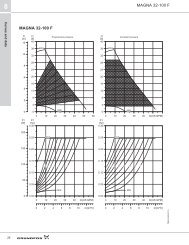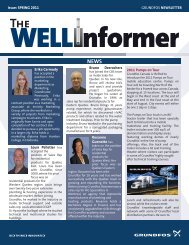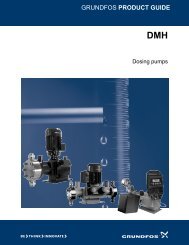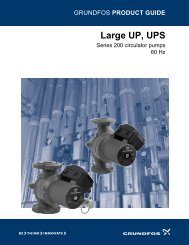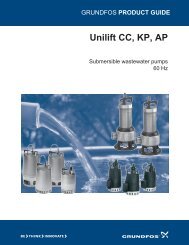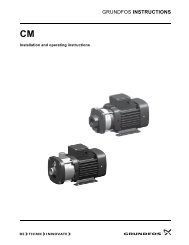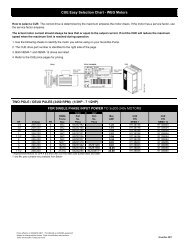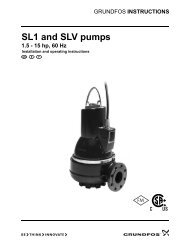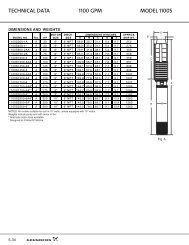Create successful ePaper yourself
Turn your PDF publications into a flip-book with our unique Google optimized e-Paper software.
<strong>Grundfos</strong> E-<strong>pumps</strong><br />
3<br />
Confirming relubrication/replacement of motor<br />
bearings (only three-phase <strong>pumps</strong>)<br />
Priority of settings<br />
The priority of settings depends on two factors:<br />
1. control source<br />
2. settings.<br />
1. Control source<br />
E-<strong>pumps</strong><br />
This function can be set to these values:<br />
• Relubricated (15-30 Hp)<br />
• Replaced<br />
• Nothing done.<br />
When the bearing monitoring function is "Active", the<br />
controller will give a warning indication when the motor<br />
bearings are due to be relubricated or replaced.<br />
See section Fault indications, page 28.<br />
When the motor bearings have been relubricated or<br />
replaced, select "Relubricated" or "Replaced" in the<br />
motor bearings screen. Then press "OK" to the screen<br />
"Relubrication/Replacement just done".<br />
Note: "Relubricated" cannot be selected for a period of<br />
time after confirming relubrication.<br />
Standstill heating (only three-phase <strong>pumps</strong>)<br />
The standstill heating function can be set to these values:<br />
• Active<br />
• Not active.<br />
When the function is set to "Active", an AC voltage will<br />
be applied to the motor windings. The applied AC<br />
voltage will ensure that sufficient heat is generated to<br />
avoid condensation in the motor.<br />
Setting via the PC Tool E-products<br />
Special setup requirements differing from the settings<br />
available via the R100 require the use of the <strong>Grundfos</strong><br />
PC Tool E-products. This again requires the assistance<br />
of a <strong>Grundfos</strong> service technician or engineer. Contact<br />
your local <strong>Grundfos</strong> company for more information.<br />
Control panel<br />
R100<br />
External signals<br />
(external setpoint signal, digital inputs, etc.)<br />
Communication from another control system via bus<br />
2. Settings<br />
• Operating mode "Stop"<br />
• operating mode "Max." (max. curve)<br />
• operating mode "Min." (min. curve)<br />
• setpoint setting.<br />
An E-pump can be controlled by different control<br />
sources at the same time, and each of these sources<br />
can be set differently. Consequently, it is necessary<br />
to set an order of priority of the control sources<br />
and the settings.<br />
Note: If two or more settings are activated at the same<br />
time, the pump will operate according to the function<br />
with the highest priority.<br />
Priority of settings without bus communication<br />
Priority Control panel or R100 External signals<br />
1 Stop<br />
2 Max.<br />
3 Stop<br />
4 Max.<br />
5 Min. Min.<br />
6 Setpoint setting Setpoint setting<br />
Example: If the E-pump has been set to operating<br />
mode "Max." (max. frequency) via an external signal,<br />
such as digital input, the control panel or the R100 can<br />
only set the E-pump to operating mode "Stop".<br />
Priority of settings with bus communication<br />
Priority<br />
Control panel<br />
or R100<br />
External<br />
signals<br />
Bus<br />
communication<br />
1 Stop<br />
2 Max.<br />
3 Stop Stop<br />
4 Max.<br />
5 Min.<br />
6 Setpoint setting<br />
Example: If the E-pump is operating according to a<br />
setpoint set via bus communication, the control panel<br />
or the R100 can set the E-pump to operating mode<br />
"Stop" or "Max.", and the external signal can only set<br />
the E-pump to operating mode "Stop".<br />
37



